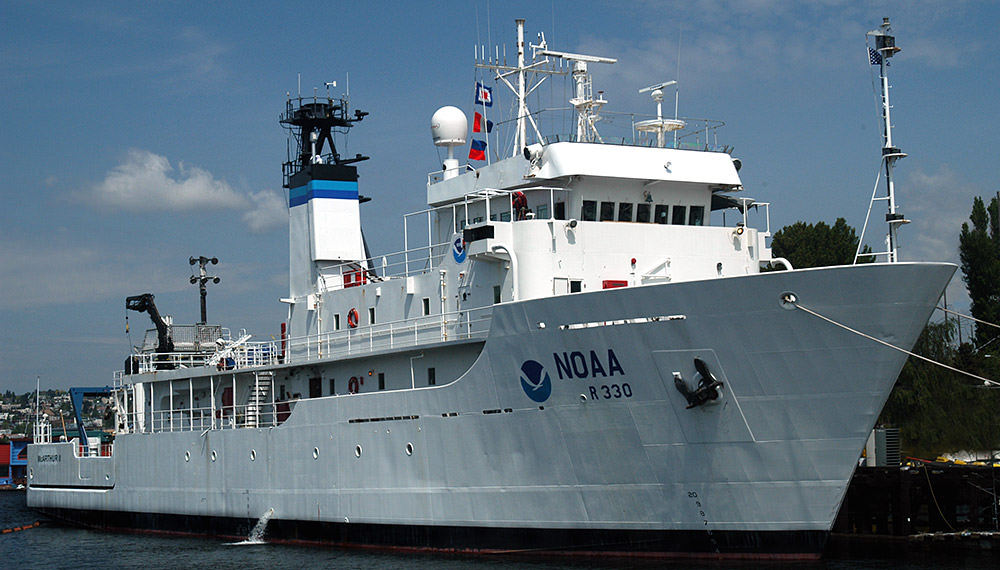Facilitating Science
Cordell Bank

There are several resources available to researchers at the Cordell Bank National Marine Sanctuary. Please contact the Research Coordinator for discussions on facilitating research within the Cordell Bank National Marine Sanctuary.
Research Coordinator: Danielle Lipski
Boats
The 67-foot R/V Fulmar is used for research, education and emergency response programs for the west coast region, including at Cordell Bank National Marine Sanctuary. The NOAA ship McArthur II conducts oceanographic research and assessments, throughout the eastern Pacific, including the U.S. West Coast, Central and South America. Cordell Bank National Marine Sanctuary also has other vessels such as Human occupied vehicle (HOV), Remotely operated vehicles (ROVs), Autonomous underwater vehicles (AUVs), and a towed camera sled which is similar in basic design to the ROV except that it is not equipped with thrusters.
Permits
Cordell Bank National Marine Sanctuary regulations provide for temporary permitting of specific activities that are not otherwise permissible. Such activities are reviewed on a case-by-case basis. Permit requests are evaluated based on their potential single and cumulative impacts to sanctuary resources versus the potential benefits the activity may provide in terms of resource protection. Permitted activities are typically research or education oriented.
A permit is required when an individual wishes to conduct an activity within a sanctuary that is otherwise prohibited. Refer to our Frequently Asked Questions to help determine if a permit is required for your proposed activity. Guidance on how to apply for a sanctuary permit can be found on this page.
The ONMS has the authority to issue permits to allow some types of activities that are otherwise prohibited by sanctuary regulations, but which generally present a public benefit by furthering the management and protection of sanctuary resources. A permit is required to conduct research within Cordell Bank National Marine Sanctuary.
http://sanctuaries.noaa.gov/management/permits/
Data Buoys
Buoys that collect real-time data on oceanic conditions have been deployed in the Cordell Bank National Marine Sanctuary. These buoys are maintained by the Scipps Institution of Oceanography and the NOAA National Data Buoy Center. Collected parameters include wind speed and direction, wave height, dominant wave period, average wave period, air temperature, water temperature and atmospheric pressure. A listing of these buoys may be accessed from here.
Diving
Recreational diving is not recommended at Cordell Bank for a number of reasons. The upper reef areas on Cordell Bank are between 115 and 140 feet and Cordell Bank typically has strong currents that are extremely variable and can run in opposite directions at different depths.
http://cordellbank.noaa.gov/visit/diving.html
http://sanctuaries.noaa.gov/visit/diving.html
Research Areas
To effectively manage the resources within the sanctuary system, scientists must understand a sanctuary's natural and cultural resources and the threats they face. Site characterization allows scientists to better understand the biodiversity, habitats, populations, communities, and ecological processes that define each sanctuary's environment. Site characterization also describes the history of the site, effects of human activities on natural systems and socioeconomic information.
We encourage projects by university faculty and students, scientists at research institutions, as well as high school students. The logistics of conducting research at this site can often be challenging, given the distance from shore and rough ocean conditions. The sanctuary may provide coordination and logistical support, vessel support and limited funding for research projects addressing priority needs.
Lab Space
Cordell Bank research department conducts and participates in numerous partnerships. The nature of these partnerships are diverse; partnerships range from funding work, to sharing assets in the field, to providing analytical support to evaluate existing or historical. Please contact specific partners to inquire for lab space available.
Accommodations
There are no accommodations available in the sanctuary, but there are hotels you can find in the area, price vary during season and vary depending on where you choose to stay.
Special Considerations
There are no special considerations that researchers need to be aware of at Cordell Bank National Marine Sanctuary.
Key Documents
Research needs
Documents that describe the immediate science needs for critical management issues.
Condition Report
The Cordell Bank NMS Condition Report is a summary of the status and trend of sanctuary resources,pressures on those resources, and management responses to the pressures that threaten the marine environment
See the Cordell Bank Library for a listing of publications, theses, posters, and other materials.

